“Backpacking in the Himalayas in the late 1980s, I first tasted fresh spring Darjeeling and I was in trouble!” recalls Camellia Sinensis tea taster and company co-founder Kevin Gascoyne, who is based in Montreal. “My taste buds were exploding and my heart hammering away from caffeine, altitude, and excitement.”
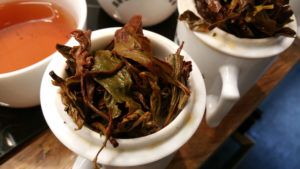
For some people, this first sip that quenches an unknown thirst is what compels them to share their joy with others. This path often leads into the professional realm, where as tasters, buyers, and trainers, communication through tea is the essence of what they do.
In this age of self-indulgent flavor descriptions and overtly exotic food vocabulary, it’s worth pondering who the taster is really talking to. How does the art of tasting benefit the tea drinker? And how does one learn how to be a better tea taster?
I put these, and other questions, to professional and passionate tasters, both from the world of tea and similarly artful taste pursuits.
Natural gift versus natural curiosity
It’s been said that there is no such thing as a “gifted” palate, only a well-trained one. Personal history in related areas of sensory exploration coupled with a natural curiosity are common themes.
According to Aaron Vick, tea buyer for the G.S. Haly Company, the oldest tea importer in the United States, it was his background in restaurant kitchens that gave him a solid familiarity with global food and drink. “I used to be known for the (perhaps excessive) specificity of my food analogies,” he says. “But as you might imagine, that wasn’t always helpful to those who hadn’t had those experiences. What was more challenging was translating those recognitions into more broadly accessible terms.”
Cynthia Fazekas, buyer and master blender for Adagio Teas, found herself wanting to taste everything all over again, with senses wide open and attuned. “It’s like getting a super power that you want to feed. And the more you feed it, the better you are at describing the teas and identifying the various characteristics,” she says.
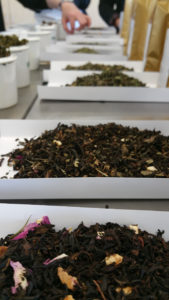
Indeed, this is a drive familiar to many who like to taste. Exactly what food or drink you’re diving into is almost irrelevant; a taster’s inquisitive nature is like a toddler’s.
“Just being in the world of tasting brings those opportunities to your front door,” says Vick. “When you show genuine curiosity about character, the people around you notice and tend to feed that curiosity by engaging you in the enthusiasm you present.” Whether it’s tasting local apple varieties in the fall or feeling the difference between alpaca and sheep fleece is immaterial, he maintains. “It’s just cool! The exercise is simple and unending: Be open to experience.”
John Laloganes is a wine sommelier and director of beverage management at Kendall College in Chicago. His lifelong passion for tasting became “official” when he made his own pairing of ginger ale and peanut butter cups at the age of 10. “I never forget the sensation of the bubbles, the flavor of the ginger, the richness of the sweetness. I remember the contrasting elements of the bubbles cutting through the fat from the peanut butter,” he says.
A living vocabulary for taste
This deep connection of vocabulary to personal memory is critical for a professional taster. But it tends to be a point of both inspiration and conundrum for new tasters. “For me, the mineral notes were hardest to feel comfortable describing. Should I lick a rock? What’s flinty versus river rock?,” says Fazekas.
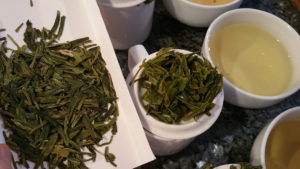
While nothing can replace the personal sensory experience, learning about how tea is made – the production process – can provide a meaningful, alternate way to make the connection on your palate.
In speaking of wine, Laloganes notes, “When you learn about it from either intellectual or practical (tasting), it becomes automatic that you learn the vocabulary associated with wine. A cool climate will likely preserve the grapes’ natural malic acid. Therefore we learn words to describe how malic acid feels in one’s mouth when tasting it.”
Lydia Kung, longtime taster and buyer with VeriLeaf Fine Teas of Southern California, feels her strongest memories of tea flavors are normally tied to a visual in some way. “Even recollections of what a benchmark tea ought to taste like are tied to memories of visits to the garden or factory,” she says. “The visual images bolster the palate memory. Even if the lexicon is inchoate rather than specific, the memory can be relied upon.”
A rose by any other name…
“I still have trouble sensing and understanding the concept of ‘briskness’ in tea,” says taste educator and researcher Virginia Utermohlen MD. “I’ve been given instruction and have read a lot, but am still somewhat befuddled.”
Utermohlen, a semi-retired associate professor of Nutritional Sciences at Cornell University, has been studying taste for nearly 20 years. She devotes a lot of her time to the pursuit of the biological nature of taste. Through biology, Utermohlen builds on this basic idea of the importance of personal experience. Why is it so common for one taster to say, for example, “asparagus,” while another leans toward “broccoli.”
“When you smell something and then give it a name, you are actually carrying out two different tasks,” she explains. “The first is to experience the smell itself, and the second is to name it. These tasks call on two different sets of nervous system processes. The first involves the olfactory patch, the olfactory bulb, and the pyriform cortex, while the second involves semantic and episodic memory, as well as emotion to help memory. The accuracy of the second task is predicated on the quality of the information provided by the first task. It is also dependent on the content of your past experiences in a complex interchange between sensation and knowledge.”
This is where previous experience and past memories come into play, she adds. “Because flowering plants, including roses, lilacs, and apples, and teas as well, all share aromatic compounds, and because each person’s array of receptors as well as past experience is their own, people will differ in what they will call a certain aroma. That’s perfectly normal. Also the smell consciousness part of our brain is (for right-handed people) on the right side of the brain, while naming is on the left. So the two may not connect easily.”
Visual tasters
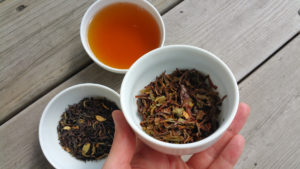
Some people have the unusual ability to tastes colors. The visual association or personal memory is so strong, they associate a color to a flavor or aroma. Other people develop fantastical images connected to the way they taste.
“Assam and Darjeeling teas were the most difficult for me,” recalls Rich Avella, founder of 4track Tea in the California Bay Area. Avella has worked with coffee and tea since the early 1990s. “Once I started to acquire a taste for them, I developed a visual to articulate my process. I saw the intense dryness in these teas as a sort of wall. I pictured reaching up to the top of the wall and pulling myself high enough to see over it, where the lush gardens of interesting flavors and aromas were: malts, grapes, flowers, vegetation.”
Kevin Gascoyne also refers to this space of sensory experience in the mind. “I’m a very visual person, so each flavor profile opens up into a three-dimensional space I call a ‘taste-scape’. Firstly, I am analyzing overall structure, and balance. Secondly, I am checking for either trademark or unusual flavor groups. Next I am checking for manufacturing defects. After thousands of cups, years, and gallons of sipping, there are corners and points in the flavor profile that I will check for problems like over-withering or poor drying.”
Tasting as communication
During training, tasters intuitively learn the art of finer communication. Early in his career, as a trainer for Peet’s Coffee & Tea, Vick learned to express his own ideas about a tea’s character. “It can’t be about parroting marketing materials,” he says. When he began dealing more with growers and processors, however, he had to adapt his way of communicating. “I was at first taken by surprise at manufacturers’ incomprehension of the language, which I had previously used so successfully with customers and trainees. The world of professional tea manufacturers has its own distinct, entrenched and quite regionally variable, vocabulary.”
As both a professor and continual student himself of many beverage disciplines, Laloganes sees another translation issue. “What made it confusing wasn’t so much the vast size of words and concepts, it was the inconsistent use of the them. I hear people using terms in a different manner than what I have been taught to believe. For example, the use of the term acidity has different explanations moving from wine to coffee to beer.”
From a scientific perspective, Utermohlen says this makes sense as some of it is inherited and beyond direct control. “The trigeminal receptor that responds to alcohol and gives you the burn is also responsive to acid. [Further], there is a genetic change – a single nucleotide polymorphism or SNP – that makes one more sensitive to the burn of alcohol.” For people without this genetic difference, the acidic experience of wine, rather than the burn, dominates their impression. She explains that these genetic differences give some people the ability to more sensitively sense bitterness in coffee and tea.
Distinctions such as these are important for tasters. They are part of how they describe the beginning, middle, and finish of a tea. Each of those points relates directly back to how the tea was manufactured, providing valuable feedback for producers. Awareness of such differences – your audience, your purpose, your own native sensitivity – can open up new paths of exploration.
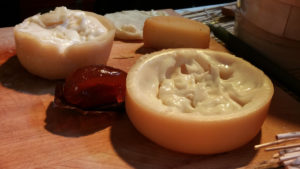
Final impressions: Tips for living the taster’s life
For many, tasting tea, writing notes, and journaling with fellow tasters becomes a metaphor for life itself. As they share, they leave themselves open to take in more. “Transferring your thoughts to paper helps that connection between the sensorial and the intellectual,” says Gascoyne. “One should try to shed that fear that there is a right and a wrong. It’s important to write the first thing that comes into your head.”
Kung agrees. She says that writing leads to greater clarification down the road. “I find that writing tasting notes forces me to refine and remember features of teas that I’ve tasted. This exercise demands articulating impressions that can be recollected, but not always precisely, unless I force myself to set them down.”
For Avella, tasting is first and foremost about sensory enjoyment, and then about description. “I don’t get as hung up as I used to on the exact words to describe what I’m tasting,” he says. “Words are never an adequate substitute for actually tasting.”
Vick takes a more contemplative viewpoint. “Above all other lessons in tasting, tea has taught me experiential patience. Some qualities are only revealed slowly, or after repeated exposure, or, most remarkably, when you’re not really paying attention at all. Understanding is not always achieved in one taste, but must be courted over time. And I’m not only talking about tea. Without constant practice, all our skills are subject to deterioration over time, aren’t they?”
To learn more about tasting tea, subscribe to Tea Journey magazine today. Carry tea knowledge wherever you go on your tablet or phone with the Tea Journey mobile app (for iOS and Android).
Tea Market
Get More Value from Your Tea: BRU Maker One
+41794574278
Jacque's Organics
(647) 804-7263
As a novice tea taster and connoisseur (almost 2 years, now) I really appreciate that even the experienced tasters are left grasping, at times, for the right description. Thank you for this article. It gives me hope.
This reply is made on behalf of Sooz.
Sooz is currently out of office until Sept.8, as she is currently on a tea teaching retreat in the woods. She will chat further when she returns.
Interesting article. I’ve been a professional tea taster in India for the last 30 years, it takes a lifetime to understand the nuances of tea, particularly when tasting Greens and Oolong’s, given that there are more than 7500 different types of teas! A smokey CTC is defective while a Lapsang Souchong is known for its smokey flavour! Light Oolong’s taste very different from dark Oolong’s…it’s very much subjective when it comes to preference. However, must admit that black teas and Darjeeling s are easier to taste and appreciate.